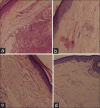Anti-inflammatory activity of roots of Cichorium intybus due to its inhibitory effect on various cytokines and antioxidant activity
- PMID: 25737610
- PMCID: PMC4342649
- DOI: 10.4103/0257-7941.150780
Anti-inflammatory activity of roots of Cichorium intybus due to its inhibitory effect on various cytokines and antioxidant activity
Abstract
Background: Cichorium intybus L. commonly known as chicory is one of the important medicinal plants commonly used in Ayurvedic system of medicine. It is commonly used for the treatment of diseases involving a khapa and pitta doshas. Traditionally, C. intybus is used for the treatment of inflammatory conditions, but there are only few in vitro studies reporting the anti-inflammatory activity of roots of chicory.
Objective: Evaluation of anti-inflammatory activity of roots of chicory and mechanisms involved in it using in vivo models of inflammation.
Materials and methods: Albino Wistar rats of either sex weighing 150-200 g were used. Ethanolic and aqueous extracts of roots of chicory were prepared with the help of Soxhlet's apparatus. The anti-inflammatory activity was studied using carrageenan-induced paw edema method and cotton pellet granuloma method. Levels of cytokines such as tumor necrosis factor alpha (TNF-α), interleukin 6 (IL-6), and IL-1 and activity of antioxidant enzymes such as catalase (CAT) and glutathione peroxidase (GPx) were estimated.
Results: Chicory roots demonstrated significant dose-dependent decrease in paw edema in carrageenan-induced paw edema method. Chicory roots diminished the serum TNF-α, IL-6, and IL-1 levels. They also significantly attenuated the malonylaldehyde levels and increased the activities of CAT and GPx in paw tissue. Similarly, chicory roots demonstrated a significant decrease in granuloma formation in cotton pellet induced granuloma method.
Conclusion: Chicory roots possess anti-inflammatory activity, and this might be due to the inhibition of various cytokines, antioxidant effects, and their free radical scavenging activity.
Keywords: Anti-inflammatory; Cichorium intybus; antioxidant activity; carrageenan; cytokines.
Conflict of interest statement
Figures



Similar articles
-
Anti-inflammatory effect of Fumaria parviflora leaves based on TNF-α, IL-1, IL-6 and antioxidant potential.Avicenna J Phytomed. 2017 Jan-Feb;7(1):37-45. Avicenna J Phytomed. 2017. PMID: 28265545 Free PMC article.
-
Cytokine Attenuation and Free Radical Scavenging Activity of a New Flavanone7,4'-Dihydroxy-3″,3″-Dimethyl -(5,6-Pyrano-2″-One)- 8- (3‴,3‴-Dimethyl Allyl)- Isolated from Mallotus philippensis: Possible Mechanism for Its Anti-Inflammatory Activity.PLoS One. 2016 Dec 12;11(12):e0167294. doi: 10.1371/journal.pone.0167294. eCollection 2016. PLoS One. 2016. PMID: 27941980 Free PMC article.
-
Antioxidant, analgesic, and anti-inflammatory activities of the ethanolic extracts of Taxillus liquidambaricola.J Ethnopharmacol. 2011 Oct 11;137(3):1161-71. doi: 10.1016/j.jep.2011.07.041. Epub 2011 Jul 22. J Ethnopharmacol. 2011. PMID: 21810460
-
Cichorium intybus: Traditional Uses, Phytochemistry, Pharmacology, and Toxicology.Evid Based Complement Alternat Med. 2013;2013:579319. doi: 10.1155/2013/579319. Epub 2013 Nov 26. Evid Based Complement Alternat Med. 2013. PMID: 24379887 Free PMC article. Review.
-
Overview of Witloof Chicory (Cichorium intybus L.) Discolorations and Their Underlying Physiological and Biochemical Causes.Front Plant Sci. 2022 Feb 23;13:843004. doi: 10.3389/fpls.2022.843004. eCollection 2022. Front Plant Sci. 2022. PMID: 35283895 Free PMC article. Review.
Cited by
-
Sexual headache from view point of Avicenna and traditional Persian medicine.Neurol Sci. 2017 Jan;38(1):193-196. doi: 10.1007/s10072-016-2741-4. Epub 2016 Oct 21. Neurol Sci. 2017. PMID: 27770272
-
The Common Cichory (Cichorium intybus L.) as a Source of Extracts with Health-Promoting Properties-A Review.Molecules. 2021 Mar 23;26(6):1814. doi: 10.3390/molecules26061814. Molecules. 2021. PMID: 33807029 Free PMC article. Review.
-
Integrated Metabolomics and Network Pharmacology to Establish the Action Mechanism of Qingrekasen Granule for Treating Nephrotic Syndrome.Front Pharmacol. 2021 Dec 6;12:765563. doi: 10.3389/fphar.2021.765563. eCollection 2021. Front Pharmacol. 2021. PMID: 34938183 Free PMC article.
-
Herbal syrup from chicory and artichoke leaves ameliorate liver damage induced by deltamethrin in weanling male rats.Environ Sci Pollut Res Int. 2020 Mar;27(7):7672-7682. doi: 10.1007/s11356-019-07434-7. Epub 2019 Dec 30. Environ Sci Pollut Res Int. 2020. PMID: 31889279
-
Hepatoprotective effects of parsley, basil, and chicory aqueous extracts against dexamethasone-induced in experimental rats.J Intercult Ethnopharmacol. 2016 Jan 27;5(1):65-71. doi: 10.5455/jice.20160124113555. eCollection 2016 Jan-Feb. J Intercult Ethnopharmacol. 2016. PMID: 27069727 Free PMC article.
References
-
- Zafar R, Mujahid Ali S. Anti-hepatotoxic effects of root and root callus extracts of Cichorium intybus L. J Ethnopharmacol. 1998;63:227–31. - PubMed
-
- Pazola Z. The chemistry of chicory and chicory-product beverages. In: Clarke RJ, Macrae R, editors. Coffee. Related Beverages. New York: Elsevier Applied Science Publishers; 1987. pp. 19–57.
-
- Kapoor LD. United States, Florida: CRC Press; 1989. CRC Handbook of Ayurvedic Medicinal Plants; pp. 114–5.
-
- Panda H. Handbook on Medicinal Herbs with Uses. New Delhi: National Institute of Industrial Research; 2002. Chicorium intybus; pp. 334–5.
-
- Roberfroid MB, Van Loo JA, Gibson GR. The bifidogenic nature of chicory inulin and its hydrolysis products. J Nutr. 1998;128:11–9. - PubMed
LinkOut - more resources
Full Text Sources
Other Literature Sources
Miscellaneous

